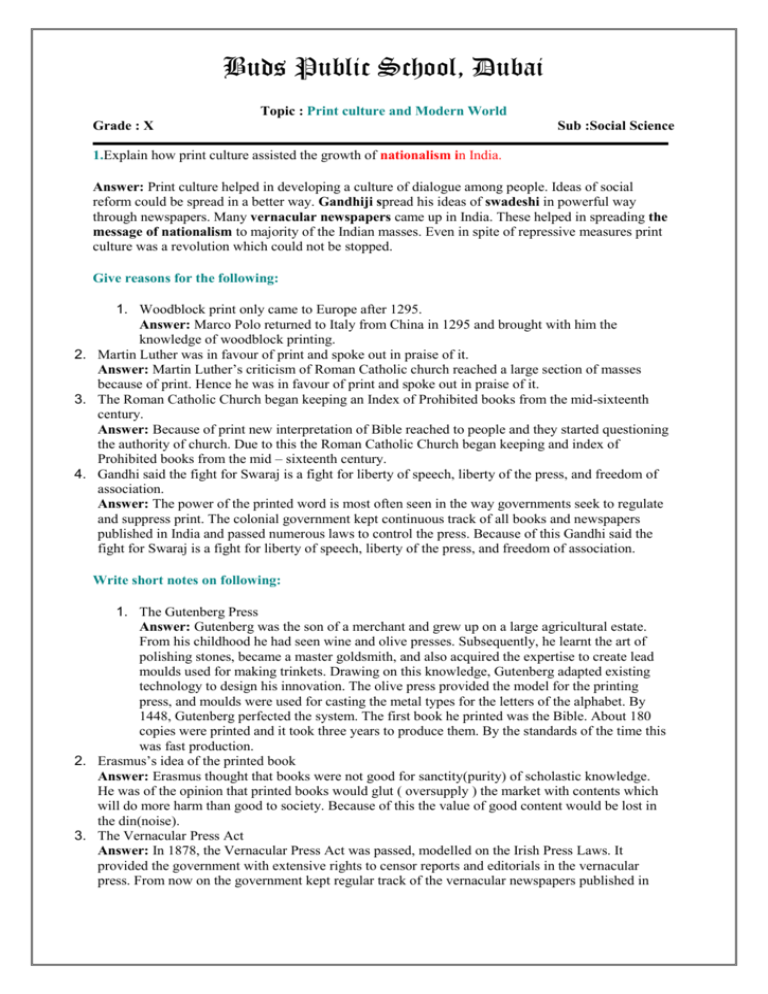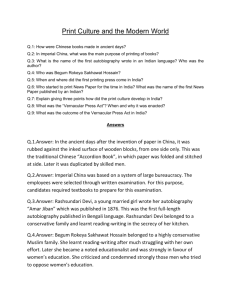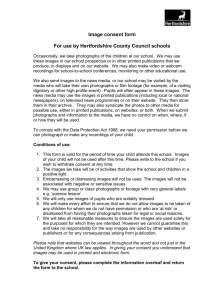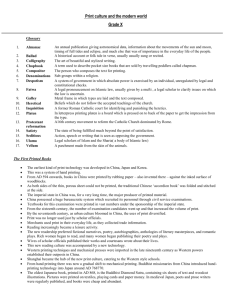Print Culture Ans key
advertisement

Buds Public School, Dubai Topic : Print culture and Modern World Grade : X Sub :Social Science 1.Explain how print culture assisted the growth of nationalism in India. Answer: Print culture helped in developing a culture of dialogue among people. Ideas of social reform could be spread in a better way. Gandhiji spread his ideas of swadeshi in powerful way through newspapers. Many vernacular newspapers came up in India. These helped in spreading the message of nationalism to majority of the Indian masses. Even in spite of repressive measures print culture was a revolution which could not be stopped. Give reasons for the following: 1. Woodblock print only came to Europe after 1295. Answer: Marco Polo returned to Italy from China in 1295 and brought with him the knowledge of woodblock printing. 2. Martin Luther was in favour of print and spoke out in praise of it. Answer: Martin Luther’s criticism of Roman Catholic church reached a large section of masses because of print. Hence he was in favour of print and spoke out in praise of it. 3. The Roman Catholic Church began keeping an Index of Prohibited books from the mid-sixteenth century. Answer: Because of print new interpretation of Bible reached to people and they started questioning the authority of church. Due to this the Roman Catholic Church began keeping and index of Prohibited books from the mid – sixteenth century. 4. Gandhi said the fight for Swaraj is a fight for liberty of speech, liberty of the press, and freedom of association. Answer: The power of the printed word is most often seen in the way governments seek to regulate and suppress print. The colonial government kept continuous track of all books and newspapers published in India and passed numerous laws to control the press. Because of this Gandhi said the fight for Swaraj is a fight for liberty of speech, liberty of the press, and freedom of association. Write short notes on following: 1. The Gutenberg Press Answer: Gutenberg was the son of a merchant and grew up on a large agricultural estate. From his childhood he had seen wine and olive presses. Subsequently, he learnt the art of polishing stones, became a master goldsmith, and also acquired the expertise to create lead moulds used for making trinkets. Drawing on this knowledge, Gutenberg adapted existing technology to design his innovation. The olive press provided the model for the printing press, and moulds were used for casting the metal types for the letters of the alphabet. By 1448, Gutenberg perfected the system. The first book he printed was the Bible. About 180 copies were printed and it took three years to produce them. By the standards of the time this was fast production. 2. Erasmus’s idea of the printed book Answer: Erasmus thought that books were not good for sanctity(purity) of scholastic knowledge. He was of the opinion that printed books would glut ( oversupply ) the market with contents which will do more harm than good to society. Because of this the value of good content would be lost in the din(noise). 3. The Vernacular Press Act Answer: In 1878, the Vernacular Press Act was passed, modelled on the Irish Press Laws. It provided the government with extensive rights to censor reports and editorials in the vernacular press. From now on the government kept regular track of the vernacular newspapers published in different provinces. When a report was judged as seditious, the newspaper was warned, and if the warning was ignored, the press was liable to be seized and the printing machinery confiscated. What did the spread of print culture in nineteenth century India mean to: a. Women Answer: Because of printing technique books became cheaper. Many hawkers started selling books from door to door. This created easy availability of books for majority of women. Apart from this many liberal males encouraged women from their families to read. Novels contained interesting descriptions of women’s lives. This created interest among women readers. Women, who were earlier cocooned inside their homes could now know about the outside world thanks to the print technology. This created a spurt of many women writers in India. It can be said that print culture not only created readers among women but also writers among them. b. The poor Answer: Very cheap small books were brought to markets in nineteenth-century Madras towns and sold at crossroads, allowing poor people traveling to markets to buy them. Public libraries were set up from the early twentieth century, expanding the access to books. From the late nineteenth century, issues of caste discrimination began to be written about in many printed tracts and essays. This helped in bringing these issues to the forefront of public consciousness. Workers in factories were too overworked and lacked the education to write much about their experiences. But some workers took initiative to write stories about their conditions. These narratives contained issues related to class oppression. So worker’s problems also came to the fore. Answer the following questions: 1. What did the spread of print culture in nineteenth century India mean to reformers? Answer: From the early nineteenth century there were intense debates around religious issues. Different groups confronted the changes happening within colonial society in different ways, and offered a variety of new interpretations of the beliefs of different religions. Some criticised existing practices and campaigned for reform, while others countered the arguments of reformers. These debates were carried out in public and in print. Printed tracts and newspapers not only spread the new ideas, but they shaped the nature of the debate. A wider public could now participate in these public discussions and express their views. New ideas emerged through these clashes of opinions. This was a time of intense controversies between social and religious reformers and the Hindu orthodoxy over matters like widow immolation, monotheism, Brahmanical priesthood and idolatry. In Bengal, as the debate developed, tracts and newspapers proliferated, circulating a variety of arguments. To reach a wider audience, the ideas were printed in the everyday, spoken language of ordinary people. 2. Why did some people in eighteenth century Europe think that print culture would bring enlightenment and end despotism? Answer: Because of print books became affordable for masses. This helped in spreading revolutionary ideas to a vast section of society in a more efficient way. Many contemporary thinkers, like Martin Luther and Monochhio could fire people’s imagination because of help from print technology. Even for scientists it became easier to share knowledge and spread knowledge. So, people in eighteenth century Europe started thinking that print culture would bring enlightenment and end despotism. 3. Why did some people fear the effect of easily available printed books? Choose one example from Europe and one from India. Answer: Not everyone welcomed the printed book, and those who did also had fears about it. Many were apprehensive of the effects that the easier access to the printed word and the wider circulation of books, could have on people’s minds. It was feared that if there was no control over what was printed and read then rebellious and irreligious thoughts might spread. If that happened the authority of ‘valuable’ literature would be destroyed. Expressed by religious authorities and monarchs, as well as many writers and artists, this anxiety was the basis of widespread criticism of the new printed literature that had began to circulate. Example from Europe: Erasmus thought that books were not good for sanctity of scholastic knowledge. He was of the opinion that printed books would glut the market with contents which will do more harm than good to society. Because of this the value of good content would be lost in the din. Example from India: Conservative Hindus believed that a literate girl would be widowed and Muslims feared that educated women would be corrupted by reading Urdu romances. 4. What were the effects of the spread of print culture for poor people in nineteenth century India? Answer: Very cheap small books were brought to markets in nineteenth-century Madras towns and sold at crossroads, allowing poor people traveling to markets to buy them. Public libraries were set up from the early twentieth century, expanding the access to books. From the late nineteenth century, issues of caste discrimination began to be written about in many printed tracts and essays. This helped in bringing these issues to the forefront of public consciousness. Workers in factories were too overworked and lacked the education to write much about their experiences. But some workers took initiative to write stories about their conditions. These narratives contained issues related to class oppression. So worker’s problems also came to the fore. 5. How did print culture affect women in the 19th century India? Answer: Because of printing technique books became cheaper. Many hawkers started selling books from door to door. This created easy availability of books for majority of women. Apart from this many liberal males encouraged women from their families to read. Novels contained interesting descriptions of women’s lives. This created interest among women readers. Women, who were earlier cocooned inside their homes could now know about the outside world thanks to the print technology. This created a spurt of many women writers in India. It can be said that print culture not only created readers among women but also writers among them. 6. Describe the role of nationalist newspaper in spreading nationalistic feelings among the people in the early 20th century. Answer: Despite repressive measures, nationalist newspapers grew in numbers in all parts of India. They reported on colonial misrule and encouraged nationalist activities. Attempts to throttle nationalist criticism provoked militant protest. This in turn led to a renewed cycle of persecution and protests. When Punjab revolutionaries were deported in 1907, Balgangadhar Tilak wrote with great sympathy about them in his Kesari. This led to his imprisonment in 1908, provoking in turn widespread protests all over India. Thus nationalist newspaper played important role in spreading nationalistic feelings among people in the early 20th century. 7. How did the print culture help scientist and philosopher? Answer: The ideas of scientists and philosophers now became more accessible to the common people. Ancient and medieval scientific texts were compiled and published, and maps and scientific diagrams were widely printed. When scientists like Isaac Newton began to publish their discoveries, they could influence a much wider circle of scientifically minded readers. The writings of thinkers such as Thomas Paine, Voltaire and Jean Jacques Rousseau were also widely printed and read. Thus their ideas about science, reason and rationality found their way into popular literature. 8. Print did not only stimulate publication of conflicting opinions among different communities but also connected them in the 19th century India. Support this statement with examples. Answer: From the early nineteenth century, as you know, there were intense debates around religious issues. Different groups confronted the changes happening within colonial society in different ways, and offered a variety of new interpretations of the beliefs of different religions. Some criticised existing practices and campaigned for reform, while others countered the arguments of reformers. These debates were carried out in public and in print. Printed tracts and newspapers not only spread the new ideas, but they shaped the nature of the debate. A wider public could now participate in these public discussions and express their views. New ideas emerged through these clashes of opinions. Print did not only stimulate the publication of conflicting opinions amongst communities, but it also connected communities and people in different parts of India. Newspapers conveyed news from one place to another, creating pan-Indian identities. 9. What do you understand by print revolution? Answer: With the printing press, a new reading public emerged. Printing reduced the cost of books. The time and labour required to produce each book came down, and multiple copies could be produced with greater ease. Books flooded the market, reaching out to an evergrowing readership. Access to books created a new culture of reading. Earlier, reading was restricted to the elites. Common people lived in a world of oral culture. They heard sacred texts read out, ballads recited, and folk tales narrated. Knowledge was transferred orally. People collectively heard a story, or saw a performance. Before the age of print, books were not only expensive but they could not be produced in sufficient numbers. Now books could reach out to wider sections of people. If earlier there was a hearing public, now a reading public came into being. 10. How were ideas and information written before the age of print in India? How did the printing technique begin in India? Explain. kvernacular languages. Manuscripts were copied on palm leaves or on handmade paper. Pages were sometimes beautifully illustrated. They would be either pressed between wooden covers or sewn together to ensure preservation. Manuscripts continued to be produced till well after the introduction of print, down to the late nineteenth century. Beginning of Printing Technique in India: The printing press first came to Goa with Portuguese missionaries in the mid-sixteenth century. Jesuit priests learnt Konkani and printed several tracts. By 1674, about 50 books had been printed in the Konkani and in Kanara languages. Catholic priests printed the first Tamil book in 1579 at Cochin, and in 1713 the first Malayalam book was printed by them. By 1710, Dutch Protestant missionaries had printed 32 Tamil texts, many of them translations of older works.







